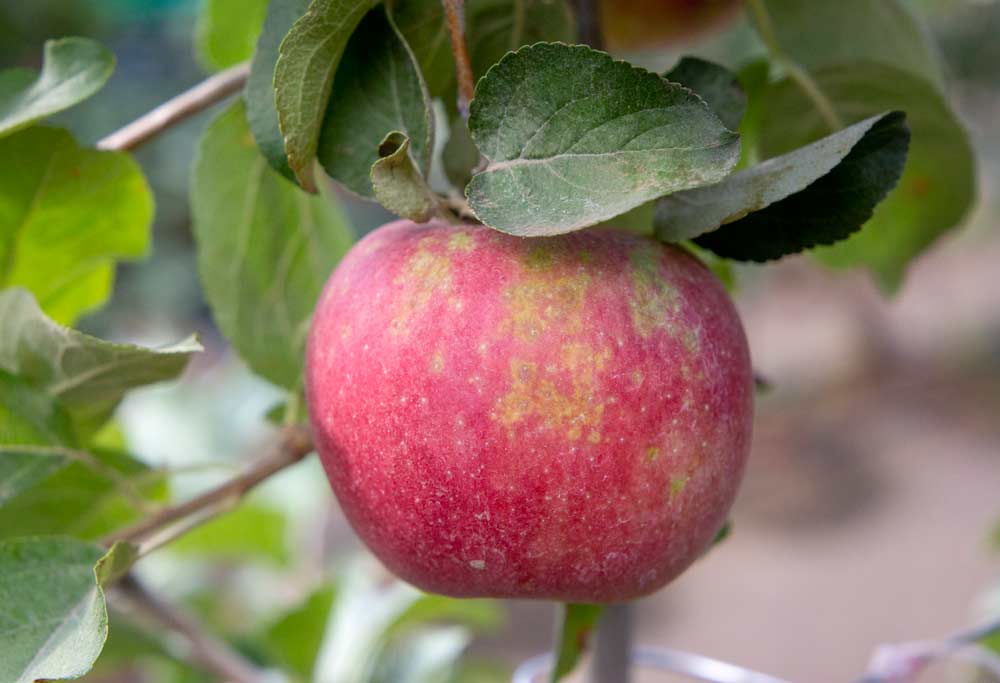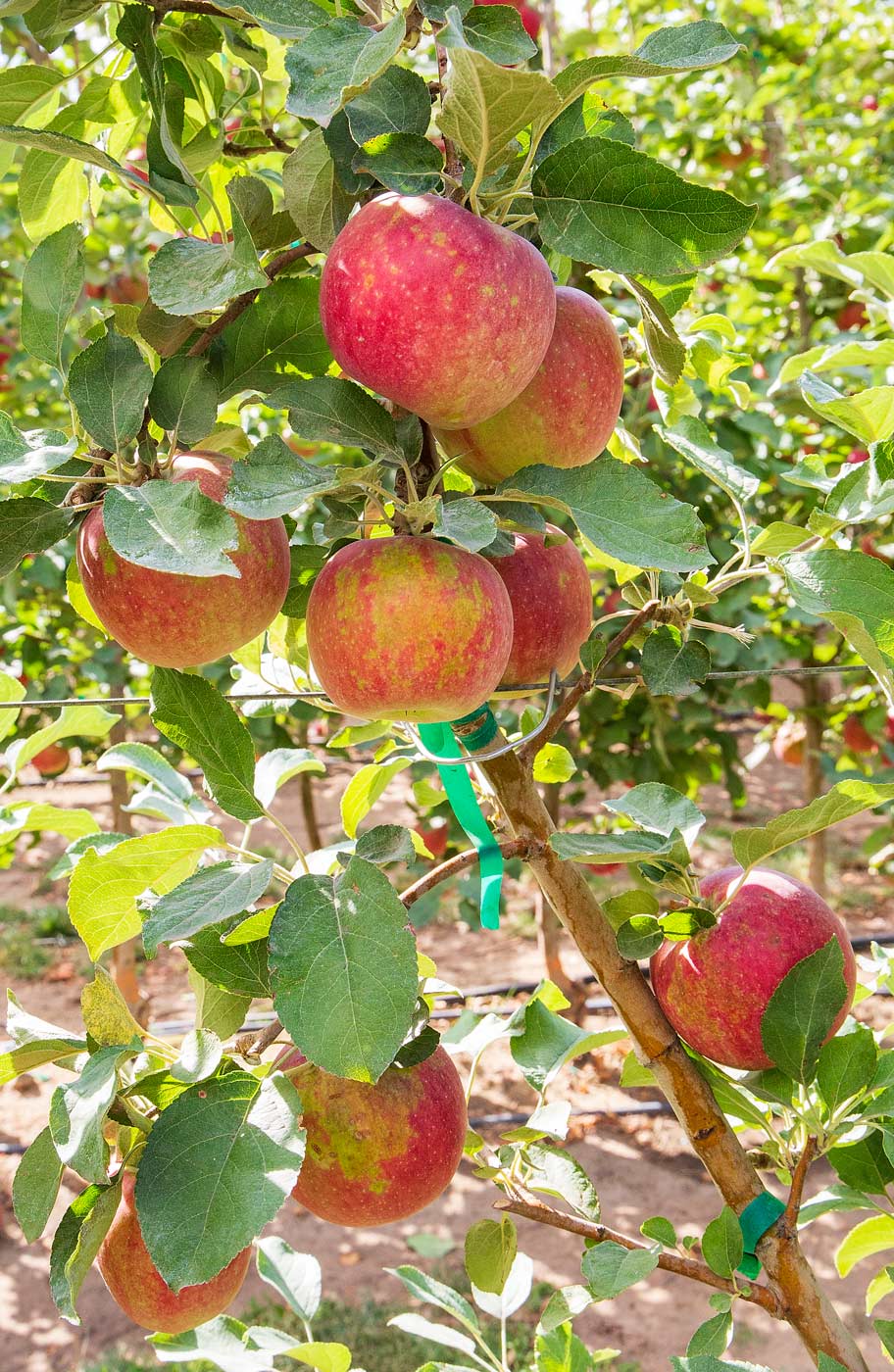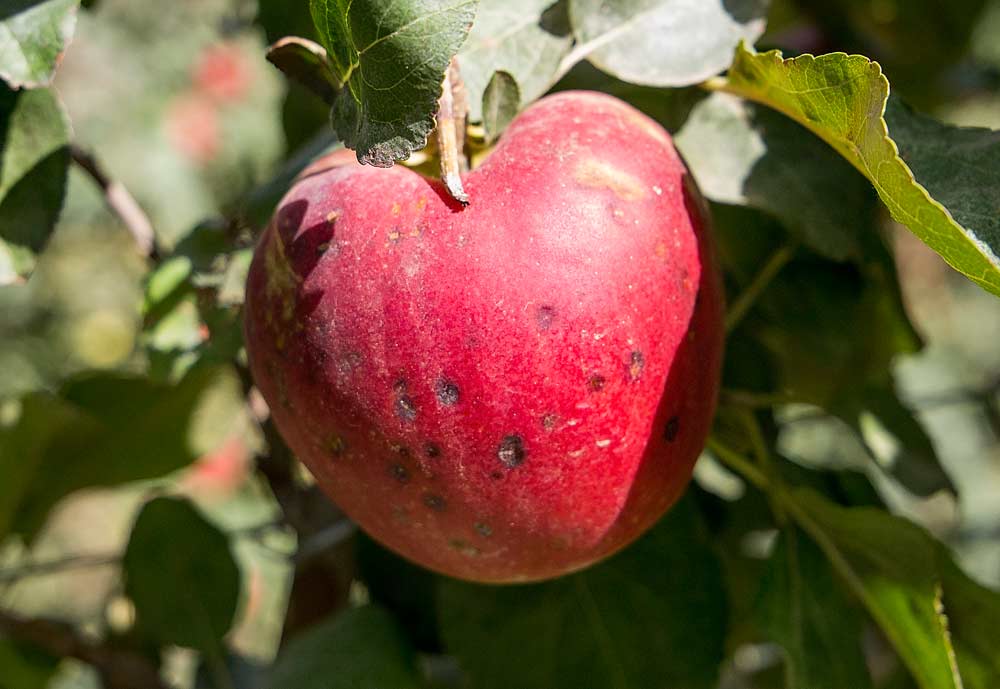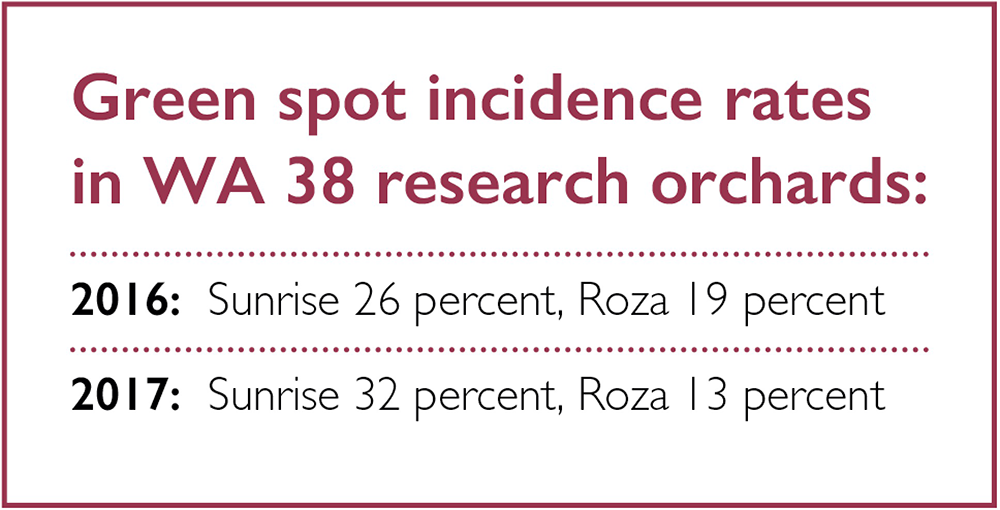
Green spot is seen on Cosmic Crisp apples in early September at the Washington State University Sunrise Research Orchard east of Wenatchee. The mysterious cosmetic condition on Washington’s newest apple doesn’t seem to be a problem in commercial orchards, though it has researchers scratching their heads in one test plot. (Ross Courtney/Good Fruit Grower)
Researchers plan to double down on their efforts to unravel the mysteries of green spot, a cosmetic condition occasionally showing up on Cosmic Crisp apples in Washington State University’s trial orchards but not in commercially managed research blocks.
The scientists behind the WA 38, to be marketed under the trade name Cosmic Crisp, have noticed green spot to some degree in the past few years, but the incidence seemed to be higher this year in Washington State University’s Sunrise Research Orchard east of Wenatchee, Washington.
WSU’s Roza Research Orchard near Prosser and research plots in two commercial orchards in Central Washington showed very few to no symptoms.
The disorder has occurred sporadically over many locations in the Sunrise orchard, but not everywhere and not every year with the same level of intensity, said Stefano Musacchi, WSU’s endowed chair of tree fruit physiology and management.
“This is a very strange situation,” Musacchi told attendees at a September field day at the Sunrise orchard.

An example of green spot on Cosmic Crisp apples in WSU’s Sunrise research orchard. (Ross Courtney/Good Fruit Grower)
Green spot appears on the fruit surface as green, unpigmented dots of varying intensity. The disorder does not necessarily mean a culled apple, researchers have stressed.
The unusual amount of green spot at Sunrise this year showed no clear pattern among training systems or rootstocks, Musacchi said.
This year, Musacchi conducted a trial at Sunrise to assess the effect of calcium sprays applied to alleviate the disorder. His initial observations suggest low efficacy, but he has yet to fully analyze the data and complete fruit mineral analyses before reaching firm conclusions.
At the field day in early September, Musacchi estimated green spot affected roughly 30 to 35 percent of the Cosmic Crisp apples in Sunrise trials — unusual but precedented. The incidence also topped 30 percent in 2016 at Sunrise.
Rates were significantly lower both years at the Roza site, according to Washington Tree Fruit Research Commission reports. Musacchi speculated differences in environmental conditions, management practices, tree vigor or a combination of those factors may explain the location variance.
Regardless of this year’s official numbers, Musacchi aims to intensify his hunt for answers. “Green spot is something that for me is a priority, because we need to understand the origin of it,” he said in follow-up comments to Good Fruit Grower.
Not all spots are equal
Apples show varying intensities of green spot. Musacchi and Ines Hanrahan, executive director of the Research Commission, use a conservative grading system that counts even a single dot. However, green spot does not automatically mean a cull. Lower levels of green spot don’t always affect eating or storage qualities.
For one thing, the condition is mostly cosmetic. Unlike bitter pit, a calcium deficiency that starts inside the apple and works its way outward, green spot appears to stay on the surface, more commonly on shaded apples, but fruit in unshaded positions on the tree can also be affected.

Researchers suspect green spot is different than bitter pit, shown here for comparison. Bitter pit appears mainly in the cortex at the calyx end of the apple as cavities with corky cells and shows up on the surface as round, subtle brown or dark green lesions. In contrast, green spot is most evident only on the fruit surface. (Ross Courtney/Good Fruit Grower)
Also, the spots don’t seem to cause any lag in fruit quality, and, so far, it is unclear if they are related to tree vigor or calcium applications, also unlike bitter pit.
Often, the spots will color out as the season progresses with no harm done.
They typically appear as coloring starts in August, said Tom Auvil of North American Plants Inc., also a former program manager for the Washington Tree Fruit Research Commission. For about two weeks, the spots are apparent, but as color increases, they disappear.
Could overhead cooling help?
At least one commercial orchardist with Cosmic Crisp test plots says overhead cooling appears to control green spot.
“Where we’ve been cooling, overhead cooling, it seems like we’ve mitigated most of it,” said Dave Allan, a semi-retired grower with Allan Bros. Inc. of Naches.
At the end of the row, where overhead cooling sometimes doesn’t reach, he finds a little more green spot. Though Allan Bros. has not planted any Cosmic Crisp on a commercial scale, the company is one of two collaborators that farm test plots of WA 38, even hosting their own field days with WSU faculty.
Allan does not regard green spot as a major concern. “I think we can figure the green spot out,” he said.
A research plot on a Stemilt Growers orchard in Quincy also showed almost no green spot this year, said researchers and Rob Blakey, Stemilt’s research and development manager.

WSU’s Sunrise orchard uses overhead cooling in some places. The university’s Roza test plots north of Prosser do not, though the university will add them in time for the 2019 growing season, said Karen Lewis, tree fruit extension regional specialist.
However, overhead cooling is only one part of the equation and may cause other problems, such as aggressive vigor, Auvil cautioned in follow-up comments with Good Fruit Grower.
The university has no research data on how overhead cooling alone affects green spot incidence, he said. The Allan Bros. blocks had minimal green spot even in drought years when water for overhead cooling was unavailable and in the years before misters were installed, Auvil said.
Obviously, commercial orchards are managed with different goals than research blocks. WSU’s trial trees received different nutritional regiments through drip irrigation than did the commercial blocks, and that may have led to different green spot outcomes, too, he said.
“Green spot may turn out to be mostly vigor-related with perhaps a nutritional twist from the … applications on the WSU farms,” Auvil said.
In the long run, Musacchi is confident the research community will find answers and solutions with time, just as they did with bitter pit.
“Research into bitter pit by WSU and (federal) scientists has developed management practices that mitigate its occurrence,” he said, also in a follow-up comment. “We need to study green spot to provide info that growers can use to optimize management.” •
–by Ross Courtney
Related story: Researchers share tips for Cosmic success
Correction: This story as printed in the December 2018 issue of Good Fruit Grower magazine incorrectly spelled bitter pit in a photo caption. We regret the error.






Leave A Comment